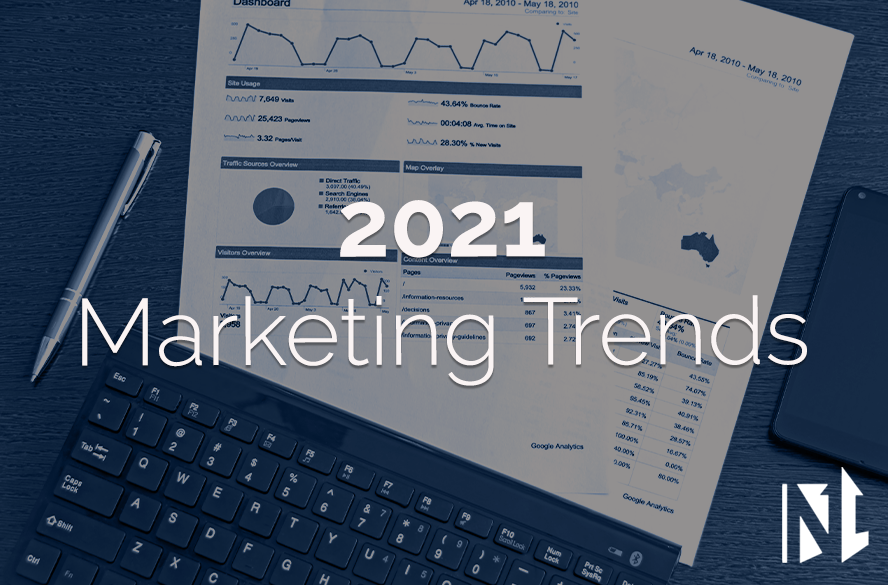2020 has changed the marketing game forever. And with 2021 around the corner, your brand should stay on top of the upcoming marketing trends. Deloitte published its 2021 Global Marketing Trends Report, which focuses on seven high-level trends all revolving around the idea of realigning your brand’s goals with your customers’ needs. Here is what you should consider when creating your 2021 marketing strategy.
Purpose
Companies that have been able to navigate through 2020 are the ones that have a strong purpose at the core of everything they do. They are able to hold themselves accountable to meet all their goals and maintain their values through major changes. Additionally, Deloitte’s 2020 survey found that 79% of respondents remember brands helping their customers, employees, and communities during the pandemic.
This means your brand should have a strong, holistic purpose that puts your customers and community at the center. Take a look at your brand’s mission statement and values and see how they align with your customers’ needs.
Agility
This past year, we all changed how we did just about everything. Our marketing strategies did the same. With more people at home and online, many brands had to make a quick move to advertising on online platforms, some of which hadn’t done so before. Brands that were able to do so successfully are brands that demonstrate agile marketing. They are always looking at where their audience is and where they will be soon in order to stay relevant.
Use data gathered from 2020 to create a picture of your customers. From there you can create ads that cater to them and predict what may be relevant soon. Your marketing strategy should be able to evolve quickly to meet your customers’ needs. It is also important to look for new tools that can help you analyze data and create effective ads. Keeping your marketing strategies relevant is the key to success here.
Human Experience
Before 2020, there was a trend towards automating customer interactions with chatbots and recorded calls. The goal was to find the most efficient way to meet the customers’ needs. These things made it easy for customers to get answers without having to talk to a real person. However, with the focus shifting onto the customers’ needs, Deloitte found that more people wanted human-centric experiences. This means not only having real people engaging with customers on all platforms, especially social media, but also showing that your brand cares about the people in your community.
Reassess your brand’s values going into 2021. Find how you can make them more human-centric. Consider having a dedicated social media team to respond to comments. Then you can use that feedback to inform your brand’s goals.
Trust
When switching your brand’s focus to the customer, consider what they value and how your goals align with that. In order to build trust with your customers, Deloitte found that your values should include humanity, transparency, capability, and reliability. They also found that customers wanted more control over how they can use products and services.
Consider these four values as well as the picture of your customer when you make promises to your customers. And always make sure you can deliver on those promises. For example, if your customers want a brand that is active in the community, consider partnering with local organizations to hold a fundraiser for COVID relief on Facebook.
Participation
People love to engage with the brands they use and social media has given them a great platform to do that. However, this participation is expanding beyond simply posting on social media or leaving an online review. Customers want to work more closely with brands. In 2020, more brands worked with brand ambassadors and used customers for product ideas and feedback.
Your brand should create platforms for your customers to interact with you. This can be active social media pages, forums, or blogs that make it easy for your audience to comment and connect. Then, you can use their feedback to inform how your brand runs and what kinds of products and services you offer.
Fusion
With the pandemic forcing businesses to change almost everything about how they operate, partnering with other businesses became a valuable strategy during the pandemic. We saw this with grocery stores and restaurants partnering with delivery apps.
Assess your brand’s weaknesses and find other businesses that can help fill in those gaps. With a partnership that complements your products and services, you can meet your customers’ needs in a more holistic way.
Talent
In 2020, teams have had to find new ways to use their talent, including assessing workflow and organization. This meant finding ways to automate or outsource repetitive tasks, which allowed them to use their staff for higher-level projects and planning. It also lead to more on-the-job training for more agile strategy.
Your brand should assess the strengths and weaknesses of its team. From there, utilize tools in place to allow them to keep learning and fill in any gaps. This will also keep them aware of new trends and help you create dynamic processes for your marketing campaigns and internal workflows.
2020 has shifted the focus of marketing for good. And for the better. With the new year around the corner, now is the time to take a look at your company’s purpose and values and realign them with your customers. So, use these marketing trends and insights to build a customer-focused marketing strategy for 2021.



